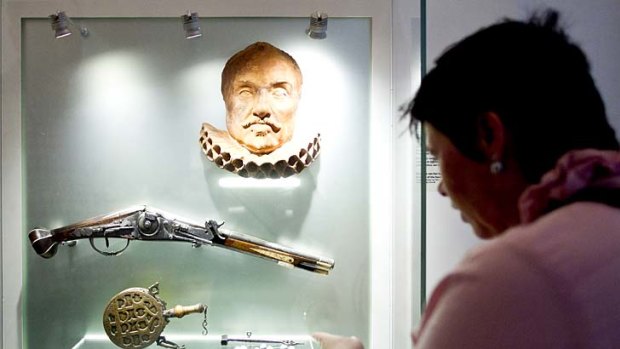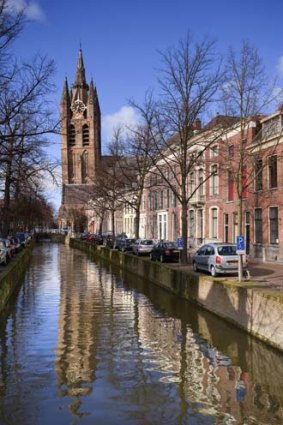
The pistol that ended the nobleman's life, at Het Prinsenhof.Credit: AFP
John Gimlette discovers a city of canalside mysteries and centuries-old mansions in southern Holland.
At the heart of Delft is a crime scene. Elsewhere, everything is in order: streets of neat cobblestones, heraldry gleaming and all the shutters a uniform civic scarlet. This isn't oppressive in any sense. It's just a reminder that, here, the Golden Age never really ended. Even the canals have survived, more than 150 kilometres of them, wandering the city.
All of which makes the murder even more outrageous. The bullet holes are still there, on the staircase at Het Prinsenhof. Scientists still measure them and write reports. It doesn't matter that the victim died in July, 1584. Over the years, thousands of reverential fingers have enlarged the holes, so now it looks as if William of Orange was blasted with a bazooka. But, of course, these aren't just holes; they connect directly to a glorious past.

Dutch treat... Oude Delft Canal and the New Church, which houses William of Orange's tomb.Credit: Getty Images
All very well, but what does it mean? Does it still appeal, this city that once grew fat on nutmeg? I decide to find out, over a long weekend. With me are a crack team of inspectors - my wife, Jayne, our six-year-old, Lucy, and granny.
Across the city, we find clues left by William everywhere, in old Delft tiles, and painted into vases. We also find a statue of his grieving dog (who had loyally starved himself to death), and a picture of William's wife (who had gone mad and been bricked up for safety).
Best of all, we find his tomb, in the New Church. The building is spectacular, but the tomb inside is unforgettable, a giant four-poster sepulchre, rendered in marble. William, on cushions of stone, is so lifelike he almost breathes.
But William, I realise, gave Delft something far more important than tombs: freedom from Spain. All around us are the trappings of new-found prosperity. I've never known a town so stuffed with mansions. The best are on Koornmarkt and Oude Delft, each full of Ming and Oriental carpets. Then there's the butter guild; an armoury dated 1601; a surgery with two front doors (royalty and plebs), and a fancy madhouse. But my favourite is Oost-Indisch Huis (East India House), dated 1631, with its thick glass and gunport shutters.
One afternoon we take a boat through the canals. Above is the pedestrian world, stitched together with humpbacked bridges, and below is another labyrinth of communication - channels and tunnels burrowing under the city.
At the heart of Delft is the main square, the Markt. Here, before turning to money, Delft's good burghers had performed one last task - the execution of William's killer.
The Markt is a sort of architectural pageant, a grand parade of buildings dressed in livery and gold. For the locals, it's still a place to bring the hunting dogs, or drink some gin. I buy a strawberry beer. The city has burnt down five times, most spectacularly in 1536 (at Het Prinsenhof, look for a beautiful map of the city in ashes). In 1654, lightning-ignited gunpowder. The stained glass in both the Old and New Church has never been replaced. Delft, however, recovered. Indeed, everyone just seemed to forget the destruction, including artist Johannes Vermeer. Vermeer left only 36 paintings, no drawings and nothing in Delft. His home is unknown but his guild has been rebuilt as a museum. There, it strikes me, his subjects, in their silk, pearl earrings and ermine, seem to radiate Delft's pride in work and guilt-free wealth.
Too soon, it is time to leave. Jayne finds a tile dated 1640. It depicts a pikeman keeping watch. I like to think the artist might even have known Vermeer, or that they had rubbed shoulders in Cafe Luna (established 1657) while knocking back a strawberry beer.
FAST FACTS
Getting there
Emirates has a fare to Amsterdam from Melbourne and Sydney for about $2090 low season including tax. Fly to Dubai (about 14hr), then Amsterdam (7hr 15min). See emirates.com. Trains depart daily from Amsterdam to Delft (1hr).
Staying there
Hotel de Vlaming overlooks the canal a few minutes' walk from the main square. Rooms from €80 ($100) a night. See hoteldevlaming.nl.
Hotel de Ark is in a converted merchant's house on the city's prettiest canal. Rooms from €147. See deark.nl.
While there
The former 15th-century convent Het Prinsenhof is open 11am-5pm (closed Mondays). Admission, €7.50. See prinsenhof-delft.nl.
Take a canal boat tour (from €12.50). Look out for the secret tunnel leading to Het Prinsenhof. See rondvaartdelft.nl.
The Royal Delft factory is open daily 9am-5pm. Entry €12. See www.royaldelft.com.
The Vermeer Centre is at 21 Voldersgracht. See vermeerdelft.nl.
More information
See www.visitholland.com.
Sign up for the Traveller Deals newsletter
Get exclusive travel deals delivered straight to your inbox. Sign up now.